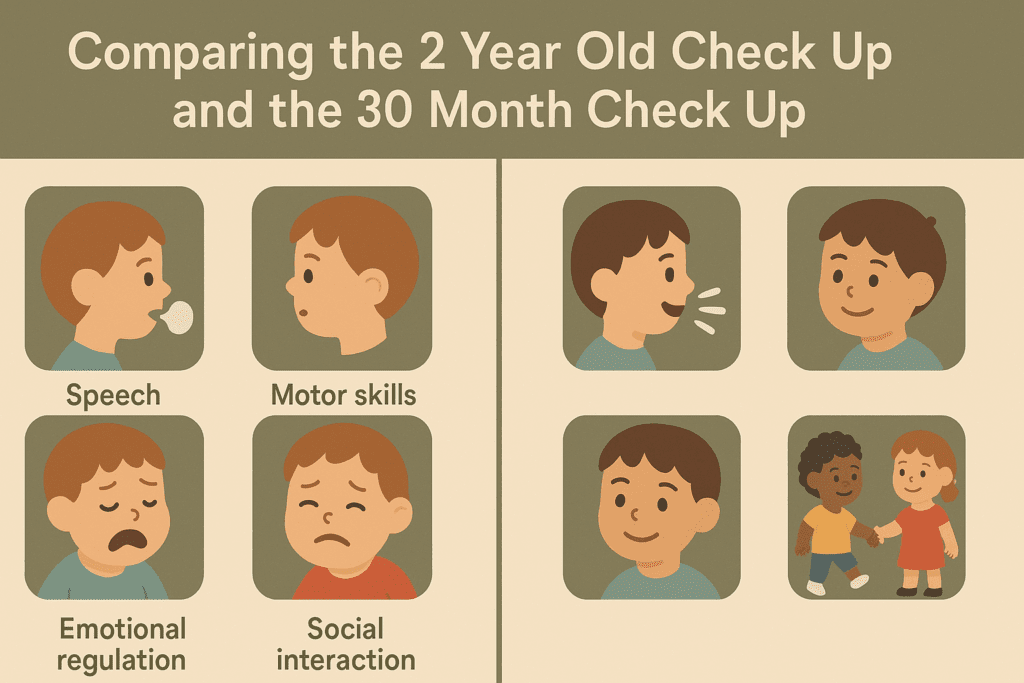As toddlers grow and develop, the importance of routine health evaluations becomes increasingly evident. One such milestone that deserves particular attention is the 30 month check up, a critical touchpoint in early childhood development that serves both as a screening opportunity and a proactive measure in preventive care. This check-up is not merely another box to tick on a pediatric schedule but a powerful tool for assessing growth, identifying early signs of developmental delays, and setting a solid foundation for lifelong wellness. For many parents, the period between the 2 year old check up and the 30 month check up may seem uneventful, yet it is often during this time that vital developmental shifts occur. Understanding the significance of this visit is essential for caregivers and healthcare providers alike.
You may also like: The Essential Guide to the Different Types of Screening Tests for Early Detection and Lasting Wellness

Understanding the Developmental Landscape Between Ages Two and Three
The toddler years are a time of rapid transformation, marked by changes in cognitive function, motor skills, language acquisition, and social-emotional development. During the interval between the 2 year old check up and the 30 month check up, children often begin to assert their independence while mastering complex skills such as multi-step directions, early counting, and symbolic play. The developmental trajectory during this time is highly variable, which can make it challenging for parents to determine whether their child’s progress falls within a typical range.
This is precisely why the 30 month check up is so important. It offers a structured opportunity for pediatricians to monitor developmental progress using validated screening tools. These assessments help detect early warning signs of conditions such as autism spectrum disorder, language delays, and behavioral issues. By catching potential concerns early, healthcare providers can initiate interventions during a critical window of neuroplasticity when the brain is most receptive to change.
The 30 Month Check Up as a Bridge in Pediatric Surveillance
While the 2 year old well child check is a well-established fixture in pediatric care, the gap until the 3-year mark can allow some issues to go unnoticed. The 30 month check up acts as a bridge in pediatric surveillance, providing a midpoint assessment that complements the broader framework of well-child visits. At this stage, healthcare professionals evaluate not only physical growth parameters but also conduct a comprehensive review of developmental domains.
Speech and language development are among the key areas of focus. A child who is not combining two to three words into sentences or following basic commands may be exhibiting early signs of a communication delay. Fine and gross motor skills are also examined. Pediatricians assess whether a child can manipulate small objects, climb stairs, or maintain balance during play. Social interactions, emotional regulation, and behavior patterns are reviewed, offering a window into how the child engages with caregivers and peers.

Why the 30 Month Check Up Is Essential for Early Detection
Early detection is a cornerstone of effective pediatric care. The 30 month check up plays an instrumental role in identifying subtle developmental differences that may otherwise be overlooked until they become more pronounced. For example, a child who exhibits restricted interests or limited eye contact may be showing preliminary signs of autism spectrum disorder. When these signs are caught early, referral to specialists and early intervention services can begin promptly, significantly improving long-term outcomes.
Additionally, this check-up can uncover physical health issues that might not have been evident at the 2 year old well child check. Growth measurements such as head circumference, weight, and height are re-evaluated to ensure consistent progression along standardized percentiles. Any significant deviations can prompt further investigation into underlying medical conditions or nutritional deficiencies. The 30 month check up thereby serves as a comprehensive checkpoint to ensure that all aspects of the child’s development and health are proceeding optimally.
The Role of Caregiver Observations and Concerns
Parental insight plays a critical role in the effectiveness of the 30 month check up. During this visit, pediatricians often rely on caregiver input to gain a full picture of the child’s behaviors in natural settings. Parents are typically asked to complete standardized questionnaires that assess a wide range of developmental milestones. These tools are designed to elicit valuable information about the child’s skills in areas such as problem-solving, expressive language, and social engagement.
This collaborative approach enhances the diagnostic accuracy of the check-up. When caregivers share specific concerns—such as a toddler not responding to their name or struggling with transitions—clinicians can tailor their assessments accordingly. Furthermore, the visit provides a unique opportunity for healthcare providers to educate parents about what to expect in the months ahead and how to support their child’s continued growth at home. Whether through reading aloud, interactive play, or establishing routines, these strategies can reinforce developmental gains and provide a nurturing environment.

Comparing the 2 Year Old Check Up and the 30 Month Check Up
Although both the 2 year old check up and the 30 month check up are designed to monitor a child’s development, they serve distinct functions within the pediatric care continuum. The 2 year old well child check is often focused on major developmental benchmarks and the early identification of common conditions such as speech delays or growth irregularities. It also typically includes vaccinations and safety guidance related to toddlers’ increasing mobility.
In contrast, the 30 month check up is more finely attuned to nuances in development. It offers a second look at areas that may have been borderline or uncertain at the 2 year mark. For instance, a child who had a mild speech delay at two may have caught up or may now show clearer signs of needing intervention. Likewise, behavioral traits that were once attributed to normal toddler temperament may begin to raise red flags for ADHD or anxiety disorders.
Understanding this distinction is key for both providers and parents. It highlights the value of viewing each well-child visit not in isolation but as part of a continuum that adapts to the child’s changing needs. By treating the 30 month check up as a unique and necessary milestone, rather than a redundant repeat of the 2 year old check up, healthcare systems can optimize early detection efforts and improve developmental surveillance.
Supporting Emotional and Behavioral Development at 30 Months
Behavioral regulation and emotional development are major areas of transformation during the toddler years. Between the 2 year old well child check and the 30 month check up, many children begin to show more complex emotions, including empathy, frustration, and fear. These changes are a normal part of maturation but can sometimes present as problematic behaviors, such as tantrums, aggression, or social withdrawal.
The 30 month check up provides a structured forum to evaluate these behaviors within the context of developmentally appropriate expectations. Pediatricians can help differentiate between behaviors that are typical for the age and those that may warrant closer observation or intervention. For example, while occasional defiance is common, persistent patterns of oppositional behavior may suggest an emerging behavioral disorder.
This visit also enables clinicians to guide parents in using evidence-based strategies for fostering emotional health. Techniques such as consistent routines, positive reinforcement, and appropriate discipline can be introduced or refined based on the child’s temperament and developmental profile. In this way, the check-up not only identifies concerns but also equips families with tools for ongoing support.

Nutrition, Sleep, and Physical Health Considerations
Beyond developmental milestones, the 30 month check up offers an opportunity to revisit important aspects of physical health, including nutrition and sleep. During this period, toddlers often become more selective eaters, which can lead to gaps in essential nutrients. Healthcare providers can assess dietary patterns and recommend adjustments or supplements as needed to ensure adequate intake of vitamins, minerals, and protein.
Sleep patterns also undergo significant changes. By 30 months, most children require 11 to 14 hours of sleep in a 24-hour period, including a daytime nap. Sleep disturbances, such as difficulty falling asleep or frequent night awakenings, may affect mood, behavior, and cognitive development. The pediatrician can offer guidance on sleep hygiene practices, bedtime routines, and address any parental concerns about sleep disruptions.
Physical health assessments during the 30 month check up include evaluations of dental hygiene, vision, and hearing. These areas are sometimes overlooked during routine visits but can have a profound impact on learning and development. For example, undiagnosed vision issues can impair a child’s ability to interact with their environment, while hearing loss may contribute to speech delays. Timely detection of these concerns can lead to effective interventions that support overall wellness.

The Importance of Consistency in Well-Child Visits
Regular pediatric check-ups form the backbone of preventive care in early childhood. Each visit, from the 2 year old well child check to the 30 month check up and beyond, builds upon the information gathered previously, allowing for a dynamic understanding of the child’s health and development. Skipping a milestone visit can create gaps in care that delay the identification of issues and the initiation of appropriate support.
The 30 month check up is particularly valuable because it comes at a time when many children are preparing for or beginning preschool. Ensuring that they are developmentally ready for this transition can ease the shift into a structured learning environment. It also provides reassurance for parents and educators, creating a shared foundation for supporting the child’s growth.
Moreover, consistent well-child visits reinforce a positive relationship between families and healthcare providers. This rapport is critical for building trust, encouraging open communication, and fostering adherence to medical advice. When parents view pediatricians as partners in their child’s care, they are more likely to seek guidance, share concerns, and follow through on recommended interventions.
The Role of Public Health and Policy in Promoting the 30 Month Check Up
Public health initiatives and healthcare policy can play a vital role in increasing awareness and access to the 30 month check up. Despite its importance, this visit is often underutilized due to gaps in insurance coverage, lack of parental awareness, or logistical challenges in scheduling. Policymakers and healthcare organizations must work together to promote this milestone as a standard component of pediatric care.
Educational campaigns targeting parents and caregivers can help highlight the benefits of the 30 month check up, dispelling the misconception that developmental issues will “sort themselves out” over time. Furthermore, integrating this check-up into publicly funded healthcare programs, such as Medicaid or the Children’s Health Insurance Program (CHIP), can ensure that all families have access to timely developmental screening, regardless of socioeconomic status.
Healthcare providers can also advocate for the inclusion of the 30 month check up in electronic medical record (EMR) reminders and scheduling systems. By prompting both clinicians and families to book this appointment, systems can reinforce its importance and minimize missed opportunities for early intervention.

Looking Ahead: Preparing for the Preschool Years and Beyond
The 30 month check up serves not only as a critical developmental screening but also as a preparatory step for the preschool years. As children approach age three, their environments often expand to include structured learning settings, peer interactions, and increased expectations for independence. Ensuring that they are physically, emotionally, and cognitively ready for these challenges can set the stage for academic and social success.
This transition also brings new considerations for parents, such as readiness for toilet training, the ability to follow multi-step instructions, and adaptability to changes in routine. These skills are evaluated during the 30 month check up, allowing healthcare providers to offer tailored guidance based on the child’s current capabilities and temperament.
By addressing these factors proactively, families can enter the preschool phase with greater confidence and a well-informed strategy for supporting continued growth. This check-up becomes not only a marker of current development but also a roadmap for future milestones, reinforcing the notion that early detection and prevention are the keys to lifelong health.
Frequently Asked Questions: Understanding the Importance of the 30 Month Check Up
What distinguishes the 30 month check up from other routine pediatric visits?
Unlike the more commonly recognized 2 year old well child check, the 30 month check up is uniquely timed to capture developmental nuances that emerge just before age three. It serves as a specialized checkpoint that focuses not only on physical growth but also on emerging cognitive, emotional, and social skills that might not have been fully evident at earlier visits. What makes it stand out is its emphasis on refined language use, early executive functioning, and pre-preschool readiness. This check-up provides the opportunity to spot less obvious concerns, such as subtle language regression or difficulty engaging in symbolic play. By including targeted assessments during this visit, clinicians can gain deeper insight into the toddler’s developmental trajectory and tailor support accordingly.
Why is it risky to skip the 30 month check up?
Many families mistakenly believe that if the 2 year old check up shows no concerns, the child is developmentally secure until age three. However, skipping the 30 month check up can result in missed opportunities for early intervention during a period when developmental delays may begin to crystallize. Certain conditions, such as autism spectrum disorder or sensory processing challenges, may not fully manifest until after the 2 year old well child check. The brain’s plasticity between ages two and three makes this an ideal window for early support that can dramatically influence long-term outcomes. Missing this checkpoint may delay essential therapies that are most effective when introduced early, potentially making future interventions more intensive or prolonged.
What new developments are often first noticed at the 30 month check up?
By 30 months, many children begin to exhibit a greater range of emotional awareness, narrative language abilities, and early problem-solving skills. It is also a period when they start to grasp cause-and-effect relationships and show a desire for greater independence. These behaviors are often more refined than those observed at the 2 year old check up and can offer clues about a child’s executive function, impulse control, and social cognition. For example, a toddler who previously followed basic instructions may now show difficulty transitioning between tasks or managing frustration, signaling a need for behavioral or emotional guidance. The 30 month check up offers clinicians and parents a unique lens through which to evaluate these more complex developmental tasks.
How do pediatricians tailor assessments during the 30 month check up?
Pediatricians use age-specific tools and developmental screening questionnaires to assess a range of domains, including language, motor skills, and socio-emotional development. While the 2 year old check up includes broader milestone evaluations, the 30 month check up narrows its focus to more nuanced behavior, such as the child’s use of pronouns, ability to complete two-step directions, and social responses in unfamiliar settings. Providers may adjust their questions and observational techniques based on family background, temperament, and cultural context to ensure accuracy. These tailored assessments help distinguish between a temporary behavioral phase and a developmental concern requiring further evaluation. Additionally, pediatricians may incorporate play-based diagnostics, using simple toys or storybooks to assess symbolic thought and imaginative play.
How does the 30 month check up support parents preparing for preschool?
For many families, the 30 month check up coincides with the preparation phase for preschool enrollment. This visit can provide invaluable insight into whether a child is socially, emotionally, and cognitively ready for group learning environments. Pediatricians can advise on key readiness indicators, such as the ability to follow routines, engage in parallel or cooperative play, and respond to redirection. These insights help parents make informed decisions about school placement, accommodations, or readiness programs. Moreover, pediatricians can connect families with community resources, parenting workshops, or behavioral therapists if additional support is needed before the transition.
What should parents monitor between the 2 year old well child check and the 30 month check up?
Between these two checkups, parents should pay close attention to language expansion, social responsiveness, motor coordination, and emotional self-regulation. While toddlers naturally develop at different rates, persistent issues like limited vocabulary growth, repetitive behaviors, or ongoing difficulty with transitions may signal underlying concerns. Parents should also observe interactions with peers, particularly in group settings, to gauge emerging social behaviors. Journaling or keeping a brief developmental log can help parents provide more accurate observations during the 30 month check up. This documentation enhances the pediatrician’s ability to pinpoint trends and evaluate whether concerns fall within typical developmental variance.
What are the long-term benefits of early detection during the 30 month check up?
Early detection at this critical stage can result in earlier access to specialized services, such as speech-language therapy, occupational therapy, or behavioral interventions. These services, when implemented before age three, are often more impactful because of the heightened neuroplasticity during this period. Children who receive timely support may experience smoother transitions into academic environments, reduced behavioral challenges, and stronger foundational skills. Research shows that children with early interventions often exhibit improved academic performance, better emotional regulation, and enhanced peer relationships. Thus, the 30 month check up plays a pivotal role in shaping a child’s long-term developmental and educational trajectory.
How do cultural and socioeconomic factors affect participation in the 30 month check up?
Families from diverse cultural or socioeconomic backgrounds may face barriers such as limited access to healthcare, language differences, or lack of awareness about the purpose of the 30 month check up. These factors can lead to lower participation rates and delayed identification of developmental concerns. Pediatric practices that incorporate culturally competent care, offer interpreter services, and conduct outreach through trusted community organizations can improve participation. It’s also helpful when public health agencies integrate the 30 month check up into existing early childhood programs, such as Head Start or Early Intervention. Equitable access ensures that all children, regardless of background, benefit from this vital developmental assessment.
How can digital health tools enhance the effectiveness of the 30 month check up?
The integration of telehealth and digital developmental screening tools is expanding the reach and effectiveness of pediatric care. Mobile applications can now help parents track milestones and complete validated screening questionnaires before the visit. This pre-visit data enables pediatricians to tailor the check-up more efficiently and spend more time addressing nuanced concerns. Additionally, video consultations may help families in rural or underserved areas complete their 30 month check up without logistical burdens. Digital platforms also offer opportunities for follow-up coaching and remote parent education, bridging the gap between clinic visits and everyday developmental support.
What behavioral health insights are uniquely assessed during the 30 month check up?
By 30 months, many children begin expressing preferences, exercising autonomy, and encountering frustration more frequently. This period marks a peak in emotional intensity, making it an ideal time to assess coping strategies, attachment patterns, and emerging behavioral norms. Pediatricians look for signs of regulation, empathy, and the child’s ability to tolerate frustration. While the 2 year old check up touches on basic behavioral concerns, the 30 month visit allows for a deeper exploration into whether behaviors fall within expected ranges or point toward emerging issues like anxiety or oppositional tendencies. These insights allow families to begin behavioral guidance early, rather than waiting until preschool or kindergarten challenges arise.
How can families maximize the value of both the 2 year old check up and the 30 month check up?
Families can view these two appointments not as standalone events but as complementary milestones in their child’s developmental journey. The 2 year old well child check provides a foundational baseline, while the 30 month check up refines and updates the child’s developmental profile. Parents should use both visits to raise any lingering questions, seek referrals when needed, and obtain actionable strategies for continued support. Keeping a running list of developmental changes and concerns between visits can help ensure no topic is overlooked. When both check-ups are prioritized and treated as essential, they form a robust framework for early detection and long-term wellness planning.
Building a Lifelong Foundation Through Early Detection
In the realm of pediatric care, early detection is not merely a clinical term; it is a philosophy that shapes how we nurture and support the youngest members of society. The 30 month check up exemplifies this philosophy, offering a uniquely powerful opportunity to identify, address, and guide a child’s development during a pivotal moment of growth. It is a visit that should not be overlooked or dismissed as redundant to the 2 year old check up but embraced as a vital component of a comprehensive wellness strategy.
Through this check-up, healthcare providers can assess nuanced shifts in behavior, cognition, and physical health that may not be evident during earlier visits. Parents gain a clearer understanding of their child’s strengths and areas for support, while also receiving expert advice on fostering optimal development at home. Together, these elements create a synergy that empowers families, strengthens communities, and lays the groundwork for thriving futures.
In a world where the earliest years set the tone for a lifetime, the value of the 30 month check up cannot be overstated. It is an essential milestone, a bridge to greater awareness, and a testament to the power of timely, compassionate, and informed care.
Further Reading:
Make the Most of Your Child’s Visit to the Doctor (Ages 1 to 4 Years)

